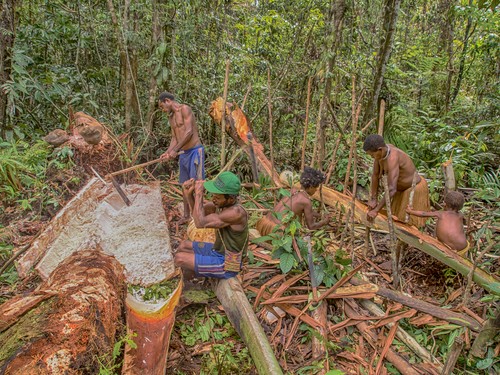Popular Reads
Top Results
Can't find what you're looking for?
View all search resultsPopular Reads
Top Results
Can't find what you're looking for?
View all search resultsNew approaches to save remaining forest
In Indonesia, both the forestry and nonforestry sectors have been implementing various certification schemes to meet the global concerns over products that come from areas that are managed in a sustainable manner.
Change text size
Gift Premium Articles
to Anyone
I
n recent years, many initiatives have been offered by NGOs to save forest ecosystems, especially tropical rain forests around the world with their rich biodiversity.
Forests are not only seen from their tangible natural resources but also their value for storing carbon and its ability to absorb carbon dioxide (CO2) from the atmosphere. Various businesses in the forestry and nonforestry sectors have been applying sustainable management principles, and one of the principles requires them to allocate some of their land for conservation purposes.
This is, of course, a show of global concern over the rapid loss of biodiversity that should be halted for our future generation. In Indonesia, both the forestry and nonforestry sectors have been implementing various certification schemes to meet the global concerns over products that come from areas that are managed in a sustainable manner.
In the late 1990s, the concept of high conservation value (HCV) forests was initiated as one of the principles of sustainable forest management standards under the Forest Stewardship Council (FSC) certification scheme. Later, this concept is adopted not only for the forestry sector but also nonforestry businesses and thus called HCV areas.
The HCV status was designed to maintain or enhance the environmental and social values in production landscapes. It is based on six values, which are species diversity (HCV 1), landscape-level ecosystems (HCV 2), rare ecosystems/habitats (HCV 3), critical ecosystem services (HCV 4), community livelihood needs (HCV 5) and cultural values (HCV 6).
Generally, HCVs 1 to 3 are significant in a global context, whilst HCVs 4 to 6 are more locally relevant. HCVs are values that are of outstanding significance or critical importance at the national, regional or global levels. They are designed to protect areas that are essential for maintaining the environmental and social values of importance.
After almost two decades, this concern over loss of forest and biodiversity was framed through a nondeforestation commitment declared by several big corporations. This idea was immediately captured by NGOs and other institutions that have joined hands in the development of a high carbon stock (HCS) approach through a multistakeholder group called the High Carbon Stock Approach (HCSA) Steering Group.
Oil palm growers Cargill, New Britain Palm Oil, Daabon, Golden Agri-Resources and Wilmar, and pulp and paper giant Asia Pulp and Paper, as well as Greenpeace, World Wide Fund for Nature, Rainforest Action Network, the Forest Trust and Forest People Program are parts of this initiative.
In principle, the HCS approach was designed to protect and restore suitable tropical forest areas in landscapes that undergo conversion for plantations or agriculture, and to ensure that the land-use rights and traditional livelihood of local communities remain secure.
This method will be useful to differentiate between natural forests and degraded forests, which have a small number of trees, shrubs or meadows. The latter is indicated by its carbon stock (less than 35 carbon tons per hectare). Thus, the HCS aims to protect remaining tree forest cover within a production zone, used for the last screening to meet the zero deforestation commitment.
The HCV approach aims to protect ecosystems outside protected areas in the landscape before converting the areas into production uses, based on precautionary approach principles. People can still manage HCV areas either by land sharing, in which development activities can be undertaken in a manner that ensures the maintenance of conservation values, or land sparing, in which HCV areas must be exclusively dedicated to conservation and development is forbidden.
That being said, the HCV approach is suitable for outside protected areas as a precautionary approach to manage natural production and industrial plantation management, including areas in zones allocated for other land uses (APL) to maintain or enhance environmental and social values in production landscapes.
This is different from the HCS approach, which is only suitable for former forested areas within state forests or APLs under conversion for nonforest land uses to save the remaining forested areas that can be protected or restored.
Both approaches are strategic to save the remaining forests in this country, and both could be combined in the case of managing former forested areas under conversion. To manage a landscape with a variety of legal forests and land statuses for biodiversity, conservation and climate smart objectives, the HCV approach should be exclusively used.
***
Titiek Setyawati is researcher at the Agency for Research Development and Innovation, the Environment and Forestry Ministry; Edi Purwanto is director of Tropenbos Indonesia.










